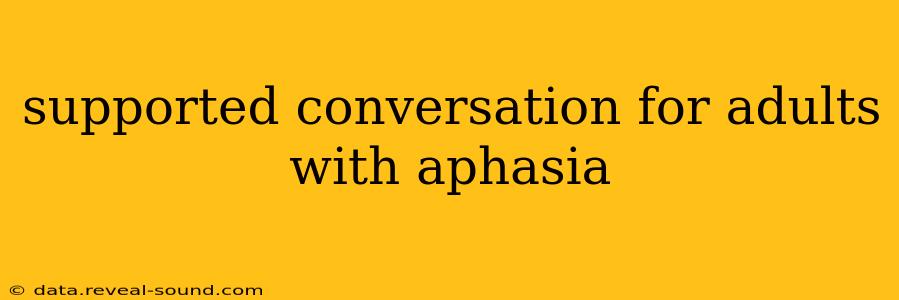Aphasia, a language disorder affecting the ability to communicate, can significantly impact daily life. For adults living with aphasia, engaging in meaningful conversations can be challenging, but with the right support and strategies, fulfilling communication is achievable. This guide explores effective techniques for supported conversation, fostering connection and understanding.
What is Supported Conversation for Adults with Aphasia?
Supported conversation for adults with aphasia involves employing various strategies to facilitate communication and overcome the challenges posed by the condition. It's not about "fixing" the aphasia, but rather creating an environment where individuals can express themselves effectively and participate fully in conversations. This includes adapting communication styles, utilizing assistive technologies, and building a supportive social network.
What are the Different Types of Aphasia?
Understanding the different types of aphasia is crucial for tailoring communication strategies. There are several types, each impacting language skills differently. These include:
- Broca's Aphasia: Difficulty producing speech, but comprehension remains relatively intact.
- Wernicke's Aphasia: Difficulty understanding language, with fluent but often nonsensical speech.
- Global Aphasia: Severe impairment in both understanding and producing language.
- Anomic Aphasia: Difficulty retrieving words, leading to word-finding difficulties.
The specific communication approach will vary depending on the individual's type and severity of aphasia.
How Can I Improve My Communication with Someone Who Has Aphasia?
Effective communication with someone who has aphasia requires patience, empathy, and a willingness to adapt your approach. Here are some key strategies:
- Speak Clearly and Slowly: Avoid rushing. Give the person time to process information.
- Use Simple Sentences: Break down complex ideas into shorter, simpler sentences.
- Use Visual Aids: Pictures, gestures, and written words can greatly enhance understanding.
- Be Patient and Encouraging: Avoid interrupting or finishing their sentences. Let them take their time.
- Focus on Understanding: Concentrate on grasping the meaning, even if the words aren't perfectly formed.
- Use Nonverbal Communication: Facial expressions, body language, and gestures can convey meaning.
- Active Listening: Pay close attention, show you're engaged, and ask clarifying questions.
What Assistive Technology Can Help with Communication?
Several assistive technologies can significantly aid communication for individuals with aphasia. These include:
- Speech-generating devices (SGDs): These devices allow individuals to select words or phrases from a screen and have them spoken aloud.
- Communication boards: Visual aids with pictures or words that facilitate communication.
- Augmentative and alternative communication (AAC) apps: Apps for smartphones and tablets that offer a range of communication tools.
What are Some Conversation Starters for Adults with Aphasia?
Choosing appropriate conversation starters is important. Avoid abstract or complex topics. Instead, focus on:
- Shared Experiences: Discuss familiar events, activities, or memories.
- Concrete Topics: Focus on tangible objects or current situations.
- Simple Questions: Use yes/no questions or questions that require short answers.
- Open-ended Questions (with caution): While open-ended questions allow for more detailed responses, ensure the individual is capable of managing the complexity.
What Support Groups or Resources are Available?
Numerous support groups and resources are available for individuals with aphasia and their caregivers. These offer valuable emotional support, information, and opportunities to connect with others facing similar challenges. Local hospitals, rehabilitation centers, and the National Aphasia Association are excellent resources to start your search.
How Can I Help Someone with Aphasia Feel Included in Conversations?
Creating an inclusive environment is crucial. This includes:
- Giving them time to speak: Don't rush or interrupt.
- Being patient and understanding: Acknowledge their efforts.
- Using inclusive language: Avoid patronizing or condescending language.
- Making adjustments: Adapt your communication style to meet their needs.
- Encouraging participation: Involve them in activities and discussions.
By implementing these strategies, we can create supportive and meaningful conversations for adults with aphasia, fostering connection and improving their quality of life. Remember that patience, understanding, and adaptability are key to effective communication.
